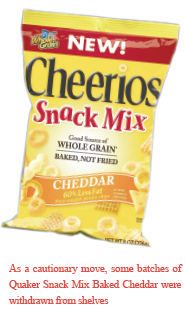
Over 150 products with hydrolysed vegetable protein have been recalled in the United States due to Salmonella contamination WITH frequent news updates on brands and products on the recall list, hydrolysed vegetable protein has been making headlines for obviously wrong reasons. More than 150 products containing HVP made by Las Vegas-based Basic Food Flavors Inc, one of the largest producers of HVP in the US, have been recalled since early March 2010 owing to Salmonella contamination. HVP, most likely extracted from soybeans, corn or wheat, is a flavour enhancer that is often blende d with other spices to design seasonings for food products. Following the discovery that Basic Food Flavors' HVP production equipment were contaminated with the potential pathogen, the U.S. Food and Drug Administration initiated a nationwide recall of several foods containing HVP paste and powder distributed by the flavour company. It is turning out to be one of the most extensive recalls to date in North America, in terms of number of food products involved within a very short span. Products ranging from soup and dip products, pasta, potato chips, bouillon products, dressing and dressing mix products, flavouring base and seasoning products, gravy mix products, sauce and marinade mix products, snack and snack mix products to frozen foods, prepared salad products, ready-to-eat meal products, and stuffing products have hit the recall line. As FDA investigators were able to spot the problem before any consequent illness outbreak could occur, the level of public health risk involved is low, the agency said. Moreover, as most of the food products containing HVP, barring uncooked ones such as ready-to-eat products in the form of dips and chips, are either cooked during the processing steps or are cooked by consumers, there is a possibility of reduction in the salmonella threat. However, to avoid complacency from its side, the FDA is taking sundry steps to instruct food industry participants and guard consumers against related probable salmonella infection.

Food companies are also displaying plenty of caution and are making voluntary recalls on products that contain even a minuscule amount of HVP. Towering costs of product recalls It is not the first time that Salmonella has turned out to be the causal pathogen for disease outbreak through the medium of food ingredients. In late 2008, a nationwide salmonella outbreak was traced to a South Georgia peanut processing plant. Unfortunately, this led to a minimum of nine deaths and hundreds of people falling ill. Above all, many food companies suffered financial losses attributed to food product recalls containing the salmonella-contaminated peanut. One such example was Kellogg Co., which lost close to $70 million in products from this food scare. It is disheartening to witness the costs associated with tainted products for food companies worldwide ever increasing. These are anticipated to inflate to a whopping value of nearly $15 billion annually in the years to come, up from approximately $400 million in 2004 (source: A.T. Kearney's consumer and retail practice in Chicago). Apart from the costs incurred by food companies in the United States, a study released by consumer and public health groups in 2010 claims that healthcare expenses associated with the food-borne illness cost is close to a mammoth $152 billion every year. These are far above the prior estimates (ranging from $7 billion to $35 billion), since this time the study took into account a total of 27 known pathogens and looked at more health-related costs. According to the CDC, an estimated 76 million people in the US contract food-borne illnesses each year and nearly 5,000 result in death.

Short-term high impact In most cases, the aftermath of any food
Adidas Energy Boost Over 150 products with hydrolysed vegetable protein have been recalled in the United States due to Salmonella contamination WITH frequent news updates on brands and products on the recall list, hydrolysed vegetable protein has been making headlines for obviously wrong reasons. More than 150 products containing HVP made by Las Vegas-based Basic Food Flavors Inc, one of the largest producers of HVP in the US, have been recalled since early March 2010 owing to Salmonella contamination. HVP, most likely extracted from soybeans, corn or wheat, is a flavour enhancer that is often blende d with other spices to design seasonings for food products. Following the discovery that Basic Food Flavors' HVP production equipment were contaminated with the potential pathogen, the U.S. Food and Drug Administration initiated a nationwide recall of several foods containing HVP paste and powder distributed by the flavour company. It is turning out to be one of the most extensive recalls to date in North America, in terms of number of food products involved within a very short span. Products ranging from soup and dip products, pasta, potato chips, bouillon products, dressing and dressing mix products, flavouring base and seasoning products, gravy mix products, sauce and marinade mix products, snack and snack mix products to frozen foods, prepared salad products, ready-to-eat meal products, and stuffing products have hit the recall line. As FDA investigators were able to spot the problem before any consequent illness outbreak could occur, the level of public health risk involved is low, the agency said. Moreover, as most of the food products containing HVP, barring uncooked ones such as ready-to-eat products in the form of dips and chips, are either cooked during the processing steps or are cooked by consumers, there is a possibility of reduction in the salmonella threat. However, to avoid complacency from its side, the FDA is taking sundry steps to instruct food industry participants and guard consumers against related probable salmonella infection.
Over 150 products with hydrolysed vegetable protein have been recalled in the United States due to Salmonella contamination WITH frequent news updates on brands and products on the recall list, hydrolysed vegetable protein has been making headlines for obviously wrong reasons. More than 150 products containing HVP made by Las Vegas-based Basic Food Flavors Inc, one of the largest producers of HVP in the US, have been recalled since early March 2010 owing to Salmonella contamination. HVP, most likely extracted from soybeans, corn or wheat, is a flavour enhancer that is often blende d with other spices to design seasonings for food products. Following the discovery that Basic Food Flavors' HVP production equipment were contaminated with the potential pathogen, the U.S. Food and Drug Administration initiated a nationwide recall of several foods containing HVP paste and powder distributed by the flavour company. It is turning out to be one of the most extensive recalls to date in North America, in terms of number of food products involved within a very short span. Products ranging from soup and dip products, pasta, potato chips, bouillon products, dressing and dressing mix products, flavouring base and seasoning products, gravy mix products, sauce and marinade mix products, snack and snack mix products to frozen foods, prepared salad products, ready-to-eat meal products, and stuffing products have hit the recall line. As FDA investigators were able to spot the problem before any consequent illness outbreak could occur, the level of public health risk involved is low, the agency said. Moreover, as most of the food products containing HVP, barring uncooked ones such as ready-to-eat products in the form of dips and chips, are either cooked during the processing steps or are cooked by consumers, there is a possibility of reduction in the salmonella threat. However, to avoid complacency from its side, the FDA is taking sundry steps to instruct food industry participants and guard consumers against related probable salmonella infection.  Food companies are also displaying plenty of caution and are making voluntary recalls on products that contain even a minuscule amount of HVP. Towering costs of product recalls It is not the first time that Salmonella has turned out to be the causal pathogen for disease outbreak through the medium of food ingredients. In late 2008, a nationwide salmonella outbreak was traced to a South Georgia peanut processing plant. Unfortunately, this led to a minimum of nine deaths and hundreds of people falling ill. Above all, many food companies suffered financial losses attributed to food product recalls containing the salmonella-contaminated peanut. One such example was Kellogg Co., which lost close to $70 million in products from this food scare. It is disheartening to witness the costs associated with tainted products for food companies worldwide ever increasing. These are anticipated to inflate to a whopping value of nearly $15 billion annually in the years to come, up from approximately $400 million in 2004 (source: A.T. Kearney's consumer and retail practice in Chicago). Apart from the costs incurred by food companies in the United States, a study released by consumer and public health groups in 2010 claims that healthcare expenses associated with the food-borne illness cost is close to a mammoth $152 billion every year. These are far above the prior estimates (ranging from $7 billion to $35 billion), since this time the study took into account a total of 27 known pathogens and looked at more health-related costs. According to the CDC, an estimated 76 million people in the US contract food-borne illnesses each year and nearly 5,000 result in death.
Food companies are also displaying plenty of caution and are making voluntary recalls on products that contain even a minuscule amount of HVP. Towering costs of product recalls It is not the first time that Salmonella has turned out to be the causal pathogen for disease outbreak through the medium of food ingredients. In late 2008, a nationwide salmonella outbreak was traced to a South Georgia peanut processing plant. Unfortunately, this led to a minimum of nine deaths and hundreds of people falling ill. Above all, many food companies suffered financial losses attributed to food product recalls containing the salmonella-contaminated peanut. One such example was Kellogg Co., which lost close to $70 million in products from this food scare. It is disheartening to witness the costs associated with tainted products for food companies worldwide ever increasing. These are anticipated to inflate to a whopping value of nearly $15 billion annually in the years to come, up from approximately $400 million in 2004 (source: A.T. Kearney's consumer and retail practice in Chicago). Apart from the costs incurred by food companies in the United States, a study released by consumer and public health groups in 2010 claims that healthcare expenses associated with the food-borne illness cost is close to a mammoth $152 billion every year. These are far above the prior estimates (ranging from $7 billion to $35 billion), since this time the study took into account a total of 27 known pathogens and looked at more health-related costs. According to the CDC, an estimated 76 million people in the US contract food-borne illnesses each year and nearly 5,000 result in death.  Short-term high impact In most cases, the aftermath of any foodAdidas Energy Boost
Short-term high impact In most cases, the aftermath of any foodAdidas Energy Boost
 iConnectHub
iConnectHub
 Login/Register
Login/Register Supplier Login
Supplier Login


























